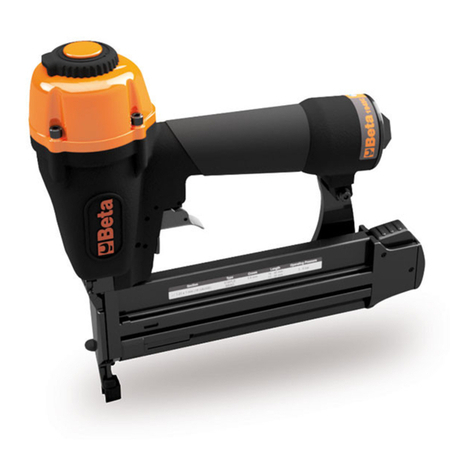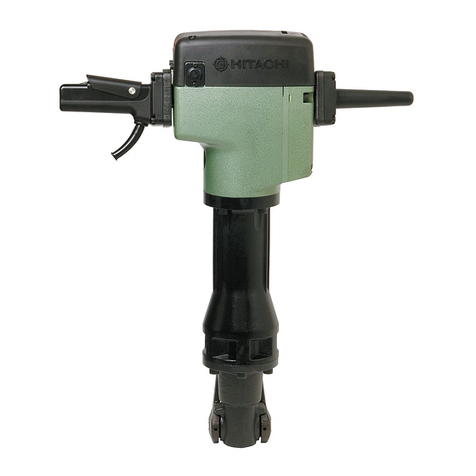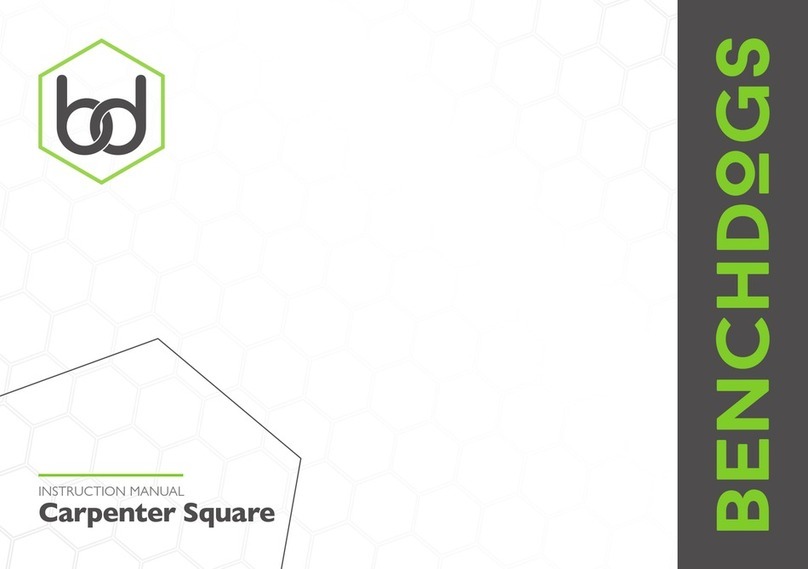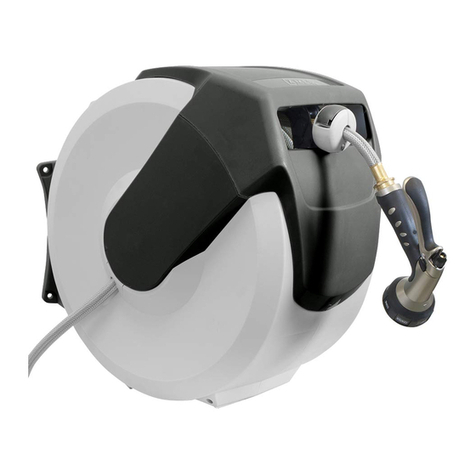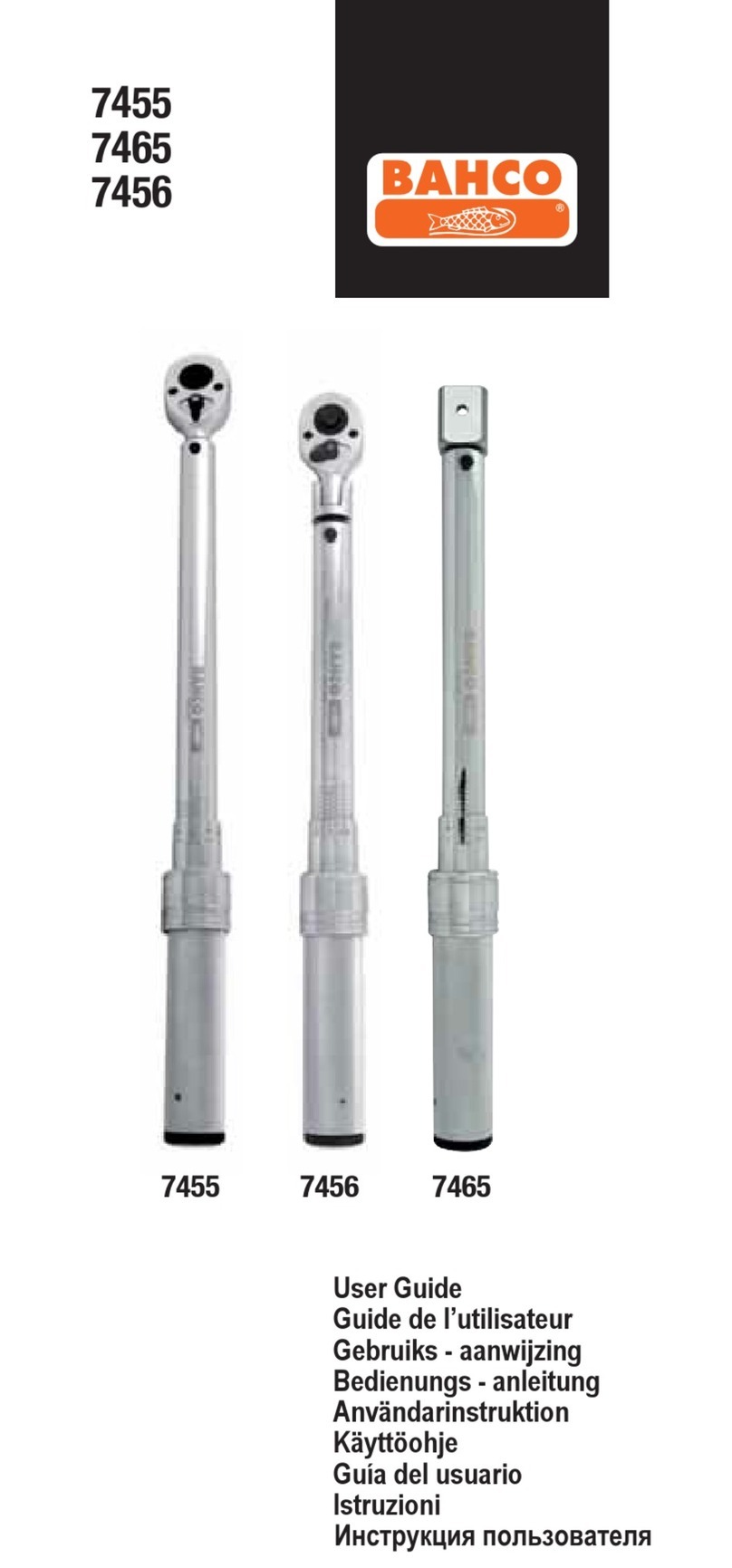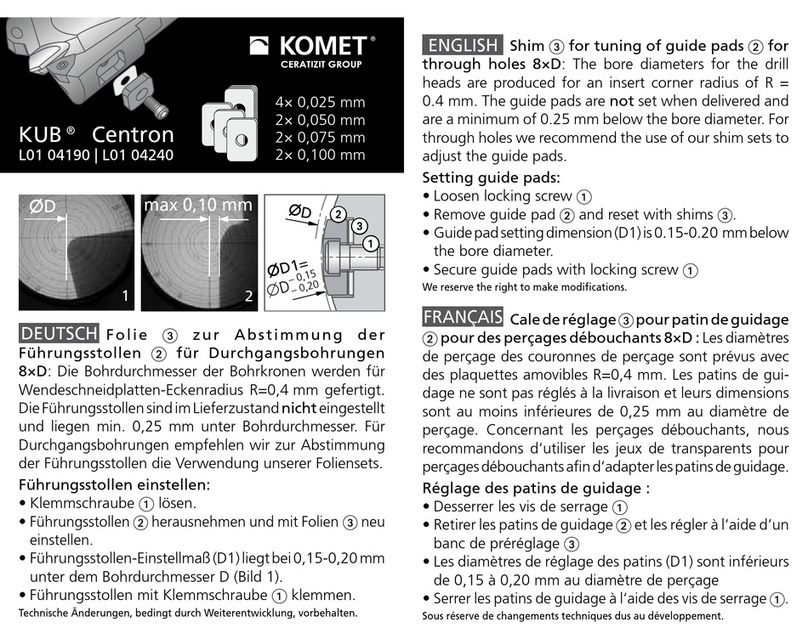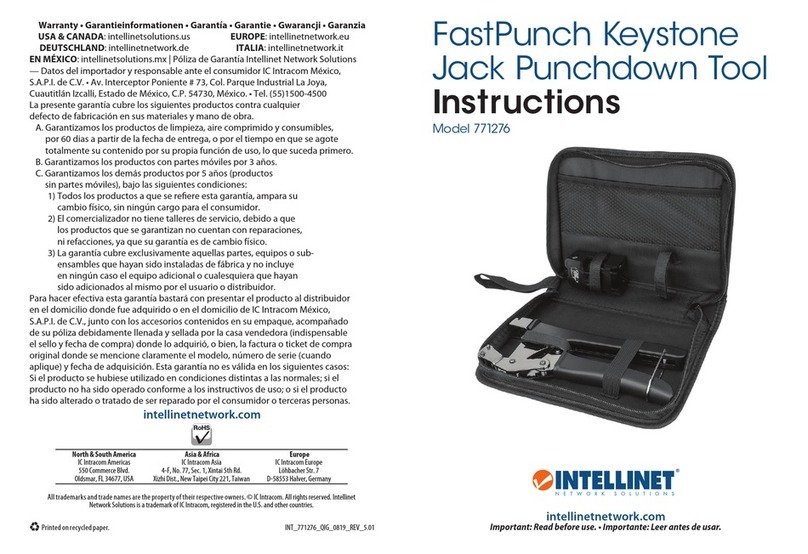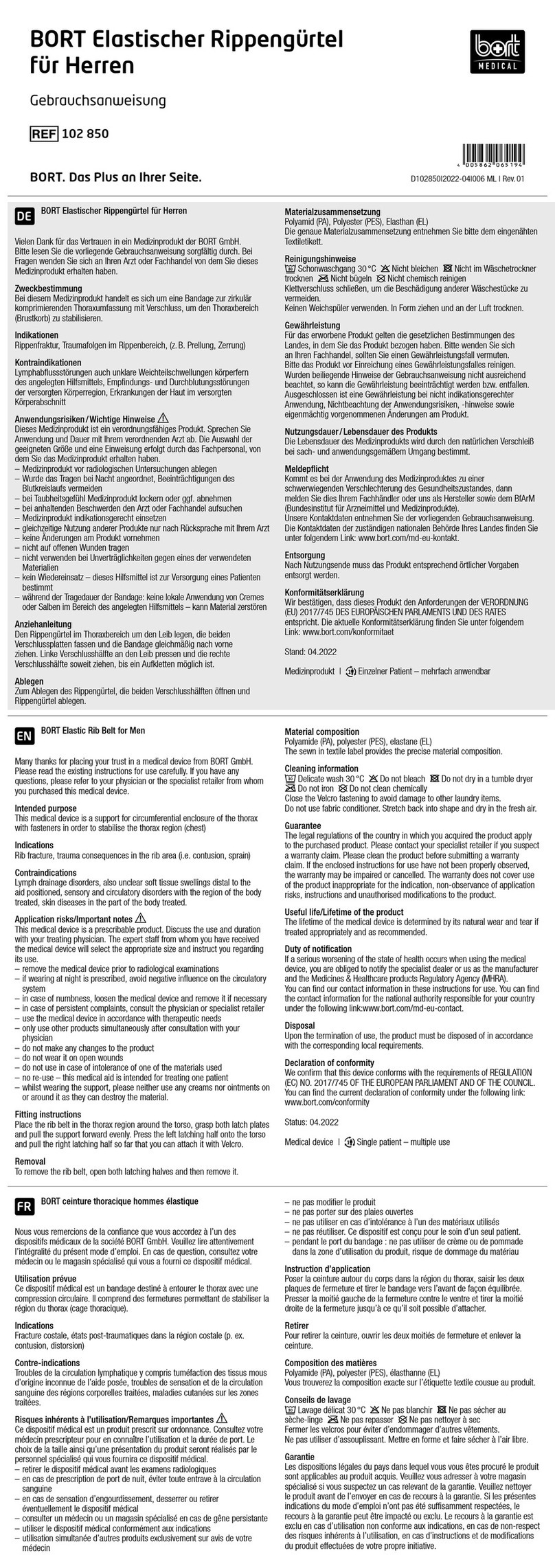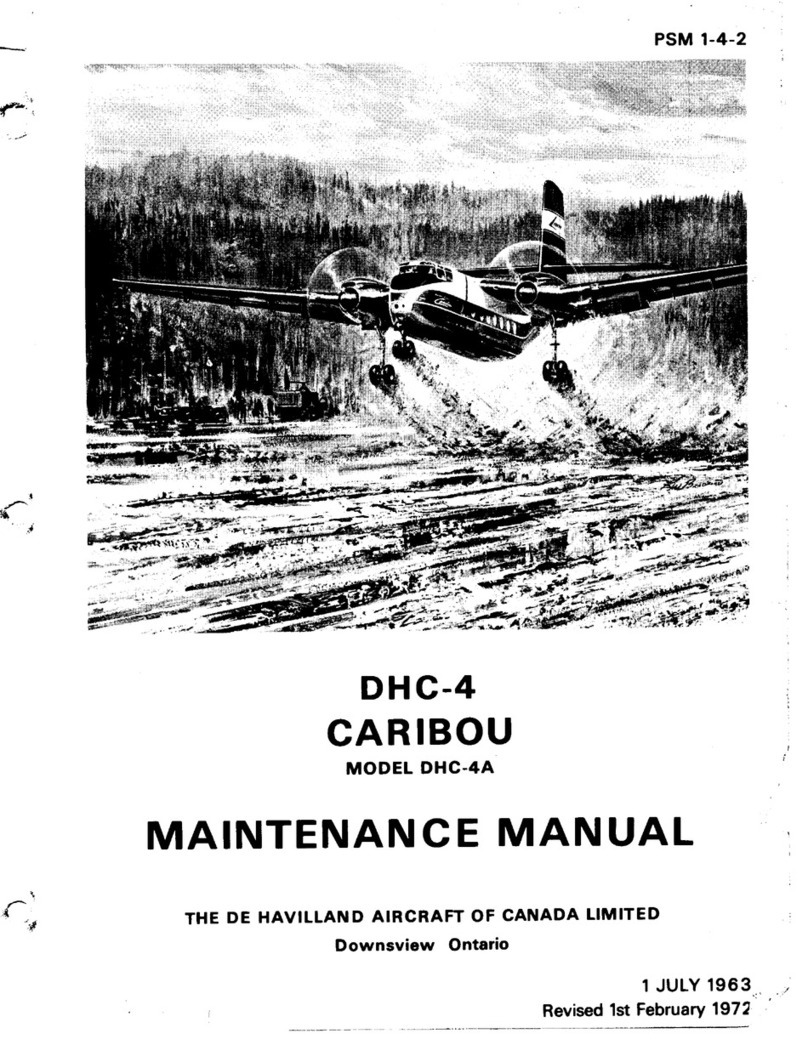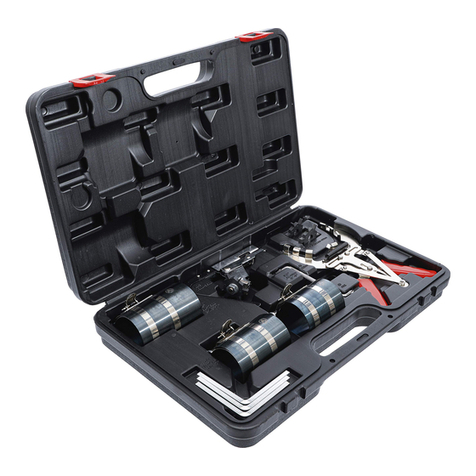CMT ORANGE TOOLS CMT11 User manual

CMT11
300W
Oscillating Multi-tool
OPERATING INSTRUCTIONS
MANUAL DE INSTRUCCIONES
INSTRUCTIONS D’EMPLOI
ISTRUZIONI D’USO
BEDIENUNGSANLEITUNG
INSTRUKCJA OBSŁUGI
ИНСТРУКЦИЯ ПО ЭКСПЛУАТАЦИИ

6
EN
www.cmtorangetools.com
1APPLICATION ............................................................................................................................7
2DESCRIPTION (FIG.A).................................................................................................................7
3PACKAGE CONTENT LIST.............................................................................................................7
4SYMBOLS .................................................................................................................................7
5GENERAL POWER TOOL SAFETY WARNINGS ................................................................................8
5.1 Working area ......................................................................................................................8
5.2 Electrical safety .................................................................................................................8
5.3 Personal safety ..................................................................................................................8
5.4 Power tool use and care ....................................................................................................8
5.5 Service ...............................................................................................................................9
6 MACHINE-SPECIFIC SAFETY WARNINGS .....................................................................................9
7ASSEMBLY ................................................................................................................................9
7.1 Mounting sanding plate saw blade/ spatula (Fig. 1) ..........................................................9
7.2 Mounting/changing the sand paper .................................................................................10
7.3 Mounting dust extraction hose .........................................................................................10
8OPERATION .............................................................................................................................10
8.1 Switching ON/OFF (Fig. 2) ...............................................................................................10
8.2 Speed adjusting (Fig. 3) ...................................................................................................10
8.3 Application tips ................................................................................................................10
8.3.1 Selecting the Application Tool/Accessory ...................................................................10
8.3.2 Sawing ......................................................................................................................10
8.3.3 Sanding .....................................................................................................................10
8.3.4 Scraping ....................................................................................................................11
9CLEANING AND MAINTENANCE ................................................................................................11
1O TECHNICAL DETAILS ................................................................................................................11
11 NOISE ....................................................................................................................................11
12 WARRANTY ..............................................................................................................................11
13 ENVIRONMENT .......................................................................................................................11
14 DECLARATION OF CONFORMITY ...............................................................................................12

7
EN
www.cmtorangetools.com
4. SYMBOLS
In this manual and/or on the machine the following
symbols are used:
Denotes risk of personal injury
or damage to the tool.
Read manual before use
Wear noise protection
Wear eye protection
In accordance with essential requirements of
the European directive(s)
Wear a mask In dusty conditions
« Class Il - The machine is double insulated;
Earthing wire is therefore not necessary. »
1. APPLICATION
Depending on which accessory mounted this power tool
is intended for dry sanding small areas and for sawing,
scraping polishing, rasping, cutting and separating.
WARNING! Read this manual and general
safety instructions carefully before using the
appliance, for your own safety. Your power
tool should only be passed on together with
these instructions.
2. DESCRIPTION (FIG. A)
1. Quick release lever
2. Quick release clamp
3. Oscillation frequency controller
4. On/Off switch
5. Vent holes
6, 7, 8, 9. Dust extraction hose & holder
10. Handle (it can be installed into A or B)
3. PACKAGE CONTENT LIST
1 x Multi-use tool
1 x Handle
1 x Vacum hose
1 x Manual
1 x Carry Case
• Remove all packaging materials.
• Remove remaining packing and
package inserts (if included).
• Check that the package contents are
complete.
• Check the appliance, the power cord,
the power plug and all accessories tor
transportation damage.
• Keep the packing materials as far as possible
till the end of the warranty period. Dispose
it into your local waste disposal system
afterwards.
WARNING: Packaging materials are not toys!
Children must not play with plastic bags!
Danger of suffocation!
lf any parts are missing or damaged, please
contact your dealer.

8
EN
www.cmtorangetools.com
WARNING Read all safety warnings and instructions. Failure to heed warnings and follow
the instructions may result in electric shock, fire and/or serious injury.
Save all warnings and instructions for future reference! The term “power tool” in the sa-
fety warnings refers to your mains-operated (corded) power tool or battery-operated (cordless) power tool.
5. GENERAL POWER TOOL SAFETY WARNINGS
5.1) Work area safety
a) Keep work area clean and well lit. Cluttered or dark
areas invite accidents.
b) Do not operate power tools in explosive atmos-
pheres, such as in the presence of flammable liq-
uids, gases or dust. Power tools create sparks which
may ignite the dust or fumes.
c) Keep children and bystanders away while operat-
ing a power tool. Distractions can cause you to lose
control of it.
5.2) Electrical safety
a) Power tool plugs must match the outlet. Never modi-
fy the plug in any way. Do not use any adapter plugs
with earthed (grounded) power tools. Unmodified
plugs and matching outlets will reduce risk of elec-
tric shock.
b) Avoid body contact with earthed or grounded sur-
faces, such as pipes, radiators, kitchen ranges and
refrigerators. There is an increased risk of electric
shock if your body is earthed or grounded.
c) Do not expose power tools to rain or wet conditions.
Water entering a power tool will increase the risk of
electric shock.
d) Do not damage the cord. Never use the cord for
carrying, pulling or unplugging the power tool. Keep
cord away from heat, oil, sharp edges or moving
parts. Damaged or entangled cords increase the
risk of electric shock.
e) When operating a power tool outdoors, use an ex-
tension cord suitable for outdoor use. Use of a cord
suitable for outdoor use reduces the risk of electric
shock.
f) If operating a power tool in a damp location is una-
voidable, use a residual current device (RCD) pro-
tected supply. Using of an RCD reduces the risk of
electric shock.
5.3) Personal safety
a) Stay alert, watch what you are doing and use com-
mon sense when operating a power tool. Do not use
a power tool while you are tired or under the influ-
ence of drugs, alcohol or medication. A moment of
inattention while operating power tools may result in
serious personal injury.
b) Use personal protective equipment. Always wear
eye protection. Protective equipment such as dust
mask, non-skid safety shoes, hard hat, or hearing
protection used for appropriate conditions will re-
duce personal injuries.
c) Prevent unintentional starting. Ensure the switch
is in the off-position before connecting to power
source and/or battery pack, picking up or carrying
the tool. Carrying power tools with your finger on
the switch or energising power tools that have the
switch on invites accidents.
d)
Remove any adjusting key or wrench before turning the
power tool on.A wrench or a key left attached to a rotat-
ing part of the power tool may result in personal injury.
e) Do not overreach. Keep proper footing and balance
firmly at all times. This enables better control of the
power tool in unexpected situations.
f) Dress properly. Do not wear loose clothing or jewel-
lery. Keep your hair, clothing and gloves away from
moving parts. Loose clothes, jewellery or long hair
can be caught in moving parts.
g) If devices are provided for the connection of dust
extraction and collection facilities, ensure these are
connected and properly used. Use of dust collection
can reduce dust-related hazards.
5.4) Power tool use and care
a)
Do not force the power tool. Use the correct pow-
er tool for your application. The correct power tool
will do the job better and safer at the rate for
which it was designed.

9
EN
www.cmtorangetools.com
b)
Do not use the power tool if the switch does not
turn it on and off. Any power tool that cannot be
controlled with the switch is dangerous and must
be repaired.
c) Disconnect the plug from the power source and/or
the battery pack from the power tool before making
any adjustments, changing accessories, or storing
power tools. Such preventive safety measures re-
duce the risk of starting the power tool accidentally.
d)
Store idle power tools out of the reach of children
and do not allow persons unfamiliar with the pow-
er tool or these instructions to operate the power
tool. Power tools are dangerous in the hands of
untrained users.
e) Maintain power tools. Check for misalignment or
binding of moving parts, breakage of parts and any
other condition that may affect the power tool’s op-
eration. If damaged, have the power tool repaired
before use. Many accidents are caused by poorly
maintained power tools.
f) Keep cutting tools sharp and clean. Properly main-
tained cutting tools with sharp cutting edges are
less likely to bind and are easier to control.
g) Use the power tool, accessories and tool bits etc. in ac-
cordance with these instructions, taking into account
the working conditions and the work to be performed.
Use of the power tool for operations different from
those intended could result in a hazardous situation.
5.5) Service
Have your power tool serviced by a qualified re-
pair person using only identical replacement parts.
This will ensure that the safety of the power tool is
maintained.
6. MACHINE-SPECIFIC
SAFETY WARNINGS
•Use the machine only for dry sanding. Penetration
of water into the machine increases the risk of an
electric shock.
•Keep hands away from the sawing range. Do not
reach under the workpiece. Contact with the saw
blade can lead to injuries.
•
Use suitable detectors to determine if utility lines
are hidden in the work area or call the local util-
ity company for assistance. Contact with electric
lines can lead to fire and electric shock. Damag-
ing a gas line can lead to explosion. Penetrating a
water line causes property damage or may cause
an electric shock.
•
When working with the machine, always hold it
firmly with both hands and provide for a secure
stance.The power tool is guided more secure with
both hands.
•Secure the workpiece. A workpiece clamped with
clamping devices or in a vice is held more secure
than by hand.
•Keep your workplace clean. Blends of materials are
particularly dangerous. Dust from light alloys can
burn or explode.
•Wear protective gloves when changing application
tools/accessories.
•Application tools/ accessories become hot after
prolonged usage.
•Do not scrape wetted materials (e. g. wallpaper) or
on moist surfaces. Penetration of water into the ma-
chine increases the risk of an electric shock.
•Do not treat the surface to be worked with solvent-
containing fluids. Materials being warmed up by the
scraping can cause toxic vapours to develop.
•
Exercise extreme caution when handling the scraper.
The accessory is very sharp; danger of injury.
7. ASSEMBLY
WARNING: Always check that the power sup-
ply corresponds to the voltage on the rating
name-plate. Remove the power tool from the
packaging. Do not plug it into the electrical
grid before assembly.
7.1)
Mounting sanding plate/ saw blade/
spatula (Fig. 1) (Not Includeed)
WARNING: Prior to assembly and adjust-
ment always pull out the power plug from the
mains socket.

10
EN
www.cmtorangetools.com
Take care with sharp tools such as spatulas, saw blades
or cutting blades.
•Loosen the clamping plate (2) by pulling the quick-
release lever (1) completely open.
•Hold the opening of the quick-install saw blade,
sanding plate or spatula toward the output spindle
which between cover clamp and clamping plate ,
push the accessory in and place it firmly onto the
locating pins.
•Fasten using the quick-release lever (1) at the lock
position as shown in the Fig. 1.
•Remove the accessory in the apposite way.
WARNING: Do not use any unmatched
accessories.
WARNING: Check the tight seating of the ap-
plication tool/accessory.
lncorrect or not securely fastened applica-
tion tools/accessories can come loose dur-
ing operation and pose a hazard.
7.2) Mounting/changing the sand pa-
per (Not Included)
With fast hook and loop fixation.
•Position the sand paper and press by hand.
•Press on the sand paper by giving it a short, firm
push against the flat surface of sanding plate (8)
and switch on the power tool.
This ensures good adhesion and prevents prema-
ture wear.
•lf the point has become worn, pull off the sand pa-
per, turn it through 120° and place it on again, or
change the sanding paper.
7.3) Mounting dust extraction hose
As shown in the Fig. 1.
8. OPERATION
8.1) Switching ON/OFF (Fig.2)
First check that the cable and plug are not damaged.
•Connect the plug to the power supply.
•Switching the power tool ON: slide ON/OFF switch
button (4) forward onto position (I).
•Switching the power tool OFF: slide ON/OFF switch
button (4) backward onto position (O).
8.2) Speed adjusting (Fig. 3)
The tool can be set at 6-speed adjustment positions. The
“1” position indicates the lowest and the “6” position indi-
cates the highest speed, you can adjust different speed by
turning the speed control dial (3) from “1” to “6” position.
The operator may have to vary the speed to optimize work-
ing efficiency.
8.3) Application tips
8.3.1) Selecting the Application
Tool/Accessory
Accessory Material
Plunge cut saw blade
wood
Wooden materials,
plastic, gypsum and other
soft materials.
Shovel blade Wood, paint, carpet
adhesive, silicone and
other elastic
materials.
Base plate for sanding Depends on sanding
sheet.
8.3.2) Sawing
Use undamaged faultless saw blades only.
Deformed, blunt saw blades or saw blades
that are otherwise damaged can break.
Plunge cuts may only be applied to soft
materials, such as wood, gypsum plaster
boards, etc.!
Before sawing with saw blades in wood, particle board,
building materials, etc., check these for foreign objects
such as nails, screws, or similar. lf required, remove for-
eign objects or use saw blades for metal.

11
EN
www.cmtorangetools.com
8.3.3) Sanding
The removal rate and the sanding pattern are primarily
determined by the choice of sanding sheet, the pre-set
oscillation rate and the applied pressure.
Only flawless sanding sheets achieve good sanding ca-
pacity and extend the service life of the machine.
Pay attention to apply uniform sanding pressure; this
increases the working life of the sanding sheets.
lntensifying the sanding pressure does not lead to an
increase of the sanding capacity, but to increased wear
of the machine and the sanding sheet.
For precise on-the-spot sanding of edges, corners and
hard to reach areas, it is also possible to work only with
the tip or an edge of the sanding plate.
When selectively sanding on the spot, the sanding sheet
can heat up considerably. Reduce the orbital stroke rate
and allow the sanding sheet to cool down regularly.
A sanding sheet that has been used for metal should
not be used for other materials.
8.3.4) Scraping
For scraping, select a high oscillation rate.
Work on a soft surface (e.g. wood) at a flat angle and
apply only light pressure. Otherwise the scraper can cut
into the surface.
9. CLEANING AND
MAINTENANCE
Before performing any work on the equip-
ment, pull the power plug.
•Keep the ventilation slots of the machine clean to
prevent overheating of the engine.
•Regularly clean the machine housing with a soft
cloth, preferably after each use.
•Keep the ventilation slots free from dust and dirt.
•lf the dirt does not come off use a soft cloth mois-
tened with soapy water.
•Never use solvents such as petrol, alcohol, ammo-
nia water, etc. These solvents may damage the plas-
tic parts.
Make sure no water can reach the inside of
the power tool!
10. TECHNICAL DETAILS
Model nr. CMT11
VoItage 220/240V
Mains frequency 50/60Hz
Power 300W
No load speed 15000-21000 min-1
Tool weight 1,5 kg
11. NOISE
Noise emission values measured according to relevant
standard. (K=3)
Acoustic pressure level LpA 82 dB(A)
Acoustic power level LwA 93 dB(A)
ATTENTION! Wear hearing protection when
sound pressure is over 85 dB(A).
aw (Vibration) 19,7 m/s2K = 1,5 m/s2
12. WARRANTY
CMT warrants to the purchaser of this product that if any
part proves to be defective due to faulty materials or work-
manship within 1 YEAR from the date of original purchase,
CMT will repair, or at its discretion replace, the faulty part
free of charge.
This warranty does not apply to commercial use nor does
it extend to normal wear and tear or damage as a result of
accident, abuse or misuse.
If the product is faulty or requires service please refer to
your nearest authorised CMT Repair Centre.
Warranty does not include any freight to and from the user.
13. ENVIRONMENT
Should your appliance need replacement
after extended use, do not dispose of it
with the household refuse, but in an envi-
ronmentally safe way.
Waste produced by electrical machine
items should not be handled like normal
household rubbish. Please recycle where recycle facili-
ties exist. Check with your Local Authority or retailer for
recycling advice.

12
EN
www.cmtorangetools.com
14. DECLARATION
OF CONFORMITY
The undersigned:
CMT Utensili S.p.A.
With address at:
Via della Meccanica
61122 Pesaro - Fraz. Chiusa di Ginestreto
Italia
Tel. #39 0721 48571
declares that
Products: MULTI-USE TOOL
Model: CMT11
is in conformity with the essential requirements and
other relevant provisions of the applicable European Di-
rectives, based on the application of European harmo-
nized standards. Any unauthorized modification of the
apparatus voids this declaration.
European Directives (including, if applicable, their
amendments up to the date of signature);
2011/65/EU
2006/42/EC
2004/ 108/EC
European harmonized standards (including, if applica-
ble, their amendments up to the date of signature);
EN60745-1: 2009
EN607 45-2-4: 2009
EN55014-1: 2006
EN55014-2: 1997
EN61000-3-2: 2006
EN61000-3-3: 2013
Keeper of the Technical Documentation:
CMT Utensili S.p.A.
The undersigned acts on behalf of the company CEO,
Signed: Marcello Tommassini
Chairman
Date: 17/03/2016

13
ES
www.cmtorangetools.com
1 UTILIZACIÓN........................................................................................................................14
2 DESCRIPCIÓN (FIG.A)...........................................................................................................14
3 CONTENIDO DEL ENVASE.....................................................................................................14
4 SIMBOLOGÍA ......................................................................................................................14
5 INSTRUCCIONES GENERALES DE SEGURIDAD…….................................................................15
5.1 Puesto de trabajo ........................................................................................................15
5.2 Seguridad eléctrica.......................................................................................................15
5.3 Seguridad de personas .................................................................................................15
5.4 Trato y uso cuidadoso de herramientas Eléctricas.........................................................16
5.5 Servicio.........................................................................................................................16
6 INSTRUCCIONES ESPECIALES DE SEGURIDAD………..............................................................16
7 MONTAJE ............................................................................................................................17
7.1 Montaje hoja de lija /hoja de sierra/espátula (Fig. 1) ..................................................17
7.2 Montaje/cambio del papel de lija.................................................................................17
7.3 Montaje de aspirador de polvo .....................................................................................17
8 OPERACIONES .....................................................................................................................17
8.1 Interruptor Encendido/Apagado ON/OFF (Fig. 2) .........................................................17
8.2 Dial de velocidad (Fig. 3) .............................................................................................18
8.3 Aplicaciones..................................................................................................................18
8.3.1 Accesorio/Material .................................................................................................18
8.3.2 Serrar.....................................................................................................................18
8.3.3 Raspar....................................................................................................................18
8.3.4 Lijar........................................................................................................................18
9 Mantenimiento y cuidado....................................................................................................18
1O INFORMACIÓN TÉCNICA .......................................................................................................19
11 RUIDO.................................................................................................................................19
12 CONDICIONES DE GARANTÍA................................................................................................19
13 PROTECCIÓN DEL MEDIO AMBIENTE.....................................................................................19
14 DECLARACIÓN DE CONFORMIDAD........................................................................................19

14
ES
www.cmtorangetools.com
1. UTILIZACIÓN
Utilice la herramienta, según el tipo de accesorio
instalado, para lijar en seco pequeñas áreas, fresar,
serrar, raspar, lijar, escofinar.
¡ADVERTENCIA! Lea íntegramente y
guarde estas advertencias de peligro e
instrucciones. Este documento se vende
junto a su herramienta.
2. DESCRIPCIÓN (FIG. A)
1. Leva de retención
2. Arandela de resorte
3. Dial de velocidad variable
4. Interruptor Encendido/Apagado On/Off
5. Rejillas de refrigeración
6, 7, 8, 9. Accesorio de aspiración y clip de la
boquilla
10. Empuñadura (en posición A o B)
3. CONTENIDO DEL ENVASE
1 x Herramienta Oscilante Multifuncional
1 x Mango de apoyo
1 x Aspirador de polvo
1 x Manual de Instrucciones
1 x Maletín de transporte
• Remover todos los embalajes
• Remover todos residuos protecciones
• Verificar que el contenido del kit es
completo
• Controlar que no hayan daños o roturas
debidos al transporte en la máquina, en
el cable, en el enchufe y accesorio.
• Guardar embalajes y envase hasta el
término de la garantía. Sólo después
desecharlos a la basura como establezca
la gestión de residuos.
¡ADVERTENCIA! Los embalajes no son
juguetes, por lo tanto deben mantenerse
fuera del alcance y de la vista de los niños.
Riesgo de asfixia.
Por favor, póngase en contacto con el
proveedor si faltan algunas partes o si hay
roturas en la herramienta.
4. SIMBOLOGÍA
En este manual se utilizan los siguientes símbolos:
Este símbolo advierte sobre una situación
peligrosa que puede comportar lesiones o
rotura de la máquina.
Lea estas advertencias antes de utilizar la
herramienta.
Al trabajar utilizar un protector acústico.
Al trabajar protegerse los ojos.
Cumple con la conformidad de las directivas
de la Comunidad Europea.
Al trabajar protegerse del polvo con
mascarilla.
« Clase II - Esta herramienta tiene doble
aislamiento. Esto hace que no sea necesario
conectar el cable de tierra. »

15
ES
www.cmtorangetools.com
¡ATENCIÓN! Lea íntegramente estas instrucciones de seguridad. La no observación de las
instrucciones de seguridad siguientes puede dar lugar a descargas eléctricas, incendios y/o lesiones graves.
¡Guarde estas instrucciones en un lugar seguro! El término “herramienta eléctrica” empleado en
las siguientes instrucciones se refiere a su aparato eléctrico portátil, ya sea con cable de red, o sin cable, en
caso de ser accionado por acumulador.
5. INSTRUCCIONES GENERALES DE SEGURIDAD PARA HERRAMIENTAS ELÉCTRICAS
5.1) Puesto de trabajo
a) Mantenga limpio y bien iluminado su puesto de
trabajo. El desorden y una iluminación deficiente
en las áreas de trabajo pueden provocar acci-
dentes.
b) No utilizar la herramienta eléctrica en un entorno
con peligro de explosión, en el que se encuentren
combustibles líquidos, gases o material en polvo.
Las herramientas eléctricas producen chispas
que pueden llegar a inflamar los materiales en
polvo o vapores.
c) Mantenga alejados a los niños y otras personas
de su puesto de trabajo al emplear la herrami-
enta eléctrica. Una distracción le puede hacer
perder el control sobre el aparato.
5.2) Seguridad eléctrica
a) El enchufe de la herramienta eléctrica debe cor-
responder a la toma de corriente utilizada. No
es admisible modificar el enchufe en forma al-
guna. No emplee adaptadores con herramientas
eléctricas dotadas de una toma de tierra. Los
enchufes sin modificas reducen el riesgo de una
descarga eléctrica.
b) Evite que su cuerpo toque partes conectadas a
tierra como tuberías, radiadores, cocinas y re-
frigeradores. El riesgo a quedar expuesto a una
sacudida eléctrica es mayor si su cuerpo tiene
contacto con tierra.
c) No exponga las herramientas eléctricas a la llu-
via y evite que penetren líquidos en su interior.
Existe el peligro de recibir una descarga eléctrica
si penetran ciertos líquidos en la herramienta
eléctrica.
d) No utilizar el cable de red para transportar o
colgar la herramienta eléctrica, ni tire de él para
sacar el enchufe de la toma de corriente. Man-
tenga el cable de red alejado del calor, aceite,
esquinas cortantes o piezas móviles. Los cables
de red dañados o enredados pueden provocar
una descarga eléctrica.
e) Al trabajar con la herramienta eléctrica a la in-
temperie utilice solamente cables de prolon-
gación homologados para su uso en exteriores.
La utilización de un cable de prolongación ade-
cuado para su uso en exteriores reduce el riesgo
de una descarga eléctrica.
f)
Si fuera necesario utilizar la herramienta eléctrica
en un entorno húmedo, utilice un interruptor de
protección diferencial. La utilización de un interrup-
tor de protección adecuado para su uso en exteri-
ores reduce el riesgo de una descarga eléctrica.
5.3) Seguridad de personas
a) Esté atento a lo que hace y emplee la herramien-
ta eléctrica con prudencia. No utilizar la herrami-
enta eléctrica si estuviese cansado, ni tampoco
después de haber consumido alcohol, drogas o
medicamentos. El no estar atento durante el uso
de una herramienta eléctrica puede provocarle
serias lesiones.
b) Utilice un equipo de protección y en todo caso
unas gafas de protección. El riesgo de lesionarse
se reduce considerablemente si, dependiendo
del tipo y la aplicación de la herramienta eléc-
trica empleada, se utiliza un equipo de protec-
ción adecuado como una mascarilla anti polvo,
zapatos de seguridad con suela antideslizante,
casco, o protectores auditivos.
c) Evite una puesta en marcha fortuita del aparato.
Asegúrese de que la herramienta eléctrica está
apagada antes de conectarla a la toma de cor-
riente y/o la batería, de desconectarla o de
transportarla. Si transporta la herramienta eléc-

16
ES
www.cmtorangetools.com
trica sujetándola por el interruptor de conexión/
desconexión, o si introduce el enchufe en la toma
de corriente con el aparato conectado, puede dar
lugar a un accidente.
d)
Retire las herramientas de ajuste o llaves fijas
antes de conectar la herramienta eléctrica. Una
herramienta o llave colocada en una pieza rotante
puede producir lesiones al ponerse a funcionar.
e) Evite trabajar con posturas forzadas. Trabaje so-
bre una base firme y mantenga el equilibrio en
todo momento. Ello le permitirá controlar mejor
la herramienta eléctrica en caso de presentarse
una situación inesperada.
f) Lleve puesta una vestimenta de trabajo ade-
cuada. No utilizar vestimenta amplia ni joyas.
Mantenga su pelo, vestimenta y guantes alejados
de las piezas móviles. La vestimenta suelta, las
joyas y el pelo largo se pueden enganchar con las
piezas en movimiento.
g) Siempre que sea posible utilizar equipos de as-
piración o captación de polvo, asegúrese que
éstos estén montados y que sean utilizados cor-
rectamente. La utilización de un equipo de as-
piración de polvo puede reducir los riesgos de
aspirar polvo nocivo para la salud.
5.4) Trato y uso cuidadoso de
herramientas eléctricas
a) No sobrecargue el aparato. Use la herramienta
prevista para el trabajo a realizar. Con la her-
ramienta adecuada podrá trabajar mejor y más
seguro dentro del margen de potencia indicado.
b) Nunca utilizar herramientas con un interruptor
defectuoso. Las herramientas que no se puedan
conectar o desconectar son peligrosas y deben
hacerse reparar.
c) Saque el enchufe de la red y/o retire la batería
antes de realizar un ajuste en la herramienta,
cambiar de accesorio o guardar el aparato. Esta
medida preventiva reduce el riesgo de conectar
accidentalmente el aparato.
d) Guarde las herramientas eléctricas fuera del al-
cance de los niños. No permita que las utilicen
personas que no estén familiarizadas con ellas o
que no hayan leído estas instrucciones. Las her-
ramientas utilizadas por personas inexpertas son
peligrosas.
e) Cuide sus herramientas eléctricas con es-
mero. Controle si funcionan correctamente, sin
atascarse, las partes móviles de la herramienta
y si existen partes rotas o deterioradas que
pudieran afectar a su funcionamiento. Si la her-
ramienta eléctrica estuviese defectuosa, hágala
reparar antes de volver a utilizarla. Muchos de los
accidentes se deben a aparatos con un manten-
imiento deficiente.
f) Mantenga los útiles limpios y afilados. Los útiles
mantenidos correctamente se dejan guiar y con-
trolar mejor.
g) Utilice las herramientas eléctricas, los accesorios,
las herramientas de inserción, etc. de acuerdo con
estas instrucciones. Considere en ello las condi-
ciones de trabajo y la tarea a realizar. El uso de
herramientas eléctricas para trabajos diferentes de
aquellos para los que han sido concebidas puede
resultar peligroso.
5.5) Servicio
Únicamente haga reparar su herramienta eléctrica
por un profesional, empleando exclusivamente piezas
de repuesto originales. Solamente así se mantiene la
seguridad de la herramienta eléctrica.
6. INSTRUCCIONES DE
SEGURIDAD ESPECIALES
•Utilizar el oscilante sólo para lijar en seco. Hacer
funcionar la máquina en condiciones húmedas
puede causar descargas eléctricas.
•
Mantenga las manos alejadas del área de trabajo y
nunca corte con sus manos debajo de la pieza.
•Siempre inspeccione la pared y los techos antes
de utilizar su herramienta, para evitar que hayan
cables de alimentación eléctrica o tuberías de
agua y gas ocultos. Perforarles puede causar
descargas eléctricas fatales.
•Durante el trabajo, agarre la herramienta de
forma segura con las dos manos para mantener
una postura firme y buen equilibrio en todo mo-
mento. Esto permite un mejor control de la her-

17
ES
www.cmtorangetools.com
ramienta eléctrica.
•Asegurar la pieza de trabajo. Utilice si es posible
herramientas de agarre tales como abrazaderas
o bloqueos.
•Mantener el área de trabajo limpia. Mezclar difer-
entes materiales y substancias químicas puede
ser peligroso. Polvo de aleaciones ligeras puede
ser inflamable o explosivo.
•Al cambiar los accesorios y para todas las demás
tareas siempre use guantes del protección.
•Partes y accesorios pueden calentarse si traba-
jan a largo plazo.
•Nunca raspar materiales húmedos (por ejemplo
papel de pared) o áreas mojadas. Si entra agua
en una herramienta eléctrica aumentará el ries-
go de descarga eléctrica.
•Nunca tratar las superficies con solventes. Al
calentarse el material puede desprender humos
tóxicos.
•Prestar atención al rascador: es muy afilado y
puede producir lesiones peligrosas.
7. MONTAJE
¡ADVERTENCIA! Asegúrese de que el volta-
je coincida con la fuente de alimentación
indicada en la etiqueta de clasificación.
Retire el cable de alimentación de la toma
de corriente antes de que cualquier man-
tenimiento o ajustes se lleven a cabo en
la unidad.
7.1) Montaje hoja de lija/hoja de sier-
ra/espátula (Fig. 1) (No Incluidos)
¡ADVERTENCIA! Antes de instalar o reem-
plazar herramientas o accesorios siempre
apague la herramienta y retire el enchufe
de la fuente de alimentación.
Evite tocar los bordes afilados de las herramientas
•Desentornille la placa de fijación (2) presion-
ando la leva de retención (1) hasta el tope.
•Ajuste la Arandela de resorte para insertar la hoja
de lija/hoja de sierra/espátula entre la arandela
misma y la placa de fijación. Apretar hasta que
encaje bien hasta los pernos de bloqueo para
cerrar.
•Bajar la leva de retención (1) hasta el bloqueo,
como se muestre en Fig. 1.
•Para quitar el accesorio hacer exactamente lo
contrario.
¡ADVERTENCIA!. Nunca utilizar accesorios
que no sean homologados y adaptados.
¡ADVERTENCIA! Asegurarse de que los ac-
cesorios sean bien encajados, un mal en-
caje puede causar que estos se pierdan
durante el trabajo, con peligros de lesiones
muy graves.
7.2) Montaje/cambio de papel de lija
(No Incluido)
Con enganche rápido y placa de fijación.
•Posicionar el papel y presionar con mano.
•Presionar hasta el clic contra la superficie de la
placa (8). Esto proporciona una buena adheren-
cia y evita el desgaste prematuro. Encender la
herramienta.
•Si el papel está desgastado se puede despren-
der y montar girado en 120° o cambiar con otro
más nuevo.
7.3) Montaje de aspirador de polvo
Como se muestre en Fig.1
8. OPERACIONES
8.1) Encender/Apagar ON/OFF (Fig.2)
Controlar que el cable de alimentación y el enchufe
no sean dañados.
•Conectar el enchufe a la fuente de alimentación.
•
Encender la herramienta en ON: deslizar el pulsador
ON/OFF (4) hacia adelante hasta la posición (I).
•Apagar la herramienta en OFF: deslizar el pulsa-
dor ON/OFF (4) hacia atrás hasta la posición (O).
8.2) Dial de velocidad (Fig. 3)
El dial de velocidad variable se puede ajustar a 6 fre-
cuencias diferentes de oscilación: se pueden adaptar

18
ES
www.cmtorangetools.com
desde "1" (min.) hasta "6" (Max.) arreglando el dial
selector (3).
8.3) Aplicaciones
8.3.1)Accesorio/Material
Accesorio Material
Hoja de sierra para cortes
de inmersión
Madera, plástico, yeso y
materiales blandos.
Rascador Madera, pintura y barniz,
moquetas, silicona y
materiales flexibles.
Hojas de lija Según de los grados de
lija.
8.3.2)Serrar
Utilizar hojas de sierra sin imperfecciones
o defectos. Hojas deformes, dañadas o
biseladas pueden romperse durante el tra-
bajo.
Se pueden efectuar cortes de inmersión
solamente en materiales blandos como
madera, yeso y paneles de yeso etc.
Revise y quite los clavos, tornillos y cualquier otro
objeto de metal de la madera antes de empezar el
trabajo.
8.3.3) Escofinar
El resultado del rascado depende del papel de es-
cofina, frecuencia de oscilación y presión durante el
trabajo.
El uso de papeles de escofina de calidad va a maxi-
mizar la vida de vuestra herramienta.
Distribuir el uso de manera uniforme para maximizar
la vida útil de sus papeles de escofina.
El exceso de presión reduce las prestaciones de la
herramienta y de los papeles.
Para escofinar esquinas, bordes y lugares de difícil
acceso es posible trabajar el material con la extremi-
dad o con el borde del papel.
No insistir en el mismo punto porque el papel puede
calentarse.
Si demasiado caliente, apague la herramienta o baje
la frecuencia de oscilación.
No emplear papel anteriormente utilizado para met-
ales para escofinar los demás materiales.
8.3.4) Lijar
Seleccionar una frecuencia de oscilación elevada
para lijar.
Para lijar una superficie blanda (ej. madera) presio-
nar suavemente hacia abajo sobre una superficie
llana, para evitar que se puedan producir cortes.
9. MANTENIMIENTO Y
CUIDADO
Siempre desconectar el enchufe de la
fuente de alimentación antes de realizar
ajustes o cambiar accesorios.
•Mantener las rejillas de refrigeración limpias para
evitar que el utensilio se caliente.
•Limpie externamente las rejillas de refrigeración
con un pañuelo suave, posiblemente después de
cada uso.
•Cuando resulte necesario limpiar la herramienta
con un pañuelo húmedo.
•Nunca utilizar disolventes como petróleos, alco-
hol, amoníaco etc. porque pueden causar daño a
las piezas de plástico de su herramienta.
Si entra agua en una herramienta eléctrica
aumenta el riesgo de descarga eléctrica.

19
ES
www.cmtorangetools.com
10. INFORMACIÓN TÉCNICA
Modelo nr. CMT11
Voltaje 220/240V
Frecuencia de la red 50/60Hz
Potencia 300W
Velocidad de oscilaciones 15000-21000 min-1
Peso eletrofresadora 1,5 kg
11. RUIDO
Los valores de emisión de ruidos respetan los es-
tándares (K=3)
Nivel de presión acústica LpA 82 dB(A)
Nivel de potencia acústica LwA 93 dB(A)
¡ADVERTENCIA! Utilizar protector acústico
con ruidos superiores a 85 db(A).
aw (Vibraciones) 19,7 m/s2K = 1,5 m/s2
13. PROTECCIÓN DEL MEDIO
AMBIENTE
No deseche los aparatos eléctricos a la
basura.
Póngase en contacto con su autoridad
local de eliminación de residuos para
obtener más detalles sobre cómo de-
shacerse de sus aparatos eléctricos
desgastados y para que puedan ser sometidos a un
reciclaje ecológico.
14. DECLARACIÓN
DE CONFORMIDAD
El abajo firmante:
CMT Utensili S.p.A.
Con dirección:
Via della Meccanica
61122 Pesaro - Fraz. Chiusa di Ginestreto
Italia
Tel. #39 0721 48571
Declara que
Producto: HERRAMIENTA OSCILANTE MULTI-
FUNCIONAL
Modelo: CMT11
Cumple los requisitos esenciales establecidos con
las disposiciones de las directivas Europeas en apli-
cación estándar de normas armonizadas.
Directivas Europeas (con sus modificaciones sucesi-
vas)
2011/65/EU
2006/42/EC
2004/ 108/EC
Normas armonizadas Europeas
(Con sus modificaciones sucesivas);
EN60745-1: 2009
EN607 45-2-4: 2009
EN55014-1: 2006
EN55014-2: 1997
EN61000-3-2: 2006
EN61000-3-3: 2013
Expediente técnico en:
CMT Utensili S.p.A.
Actos firmados por CEO de la Sociedad,
Firmado por: Marcello Tommassini
Presidente
Data: 17/03/2016

20
FR
www.cmtorangetools.com
1APPLICATION ..................................................................................................................... 21
2DESCRIPTION (FIG.A)......................................................................................................... 21
3LISTE DU CONTENU DE L’EMBALLAGE................................................................................. 21
4SYMBOLES ....................................................................................................................... 21
5AVERTISSEMENTS GÉNÉRAUX DE SÉCURITÉ RELATIFS AUX MACHINES-OUTILS .................... 22
5.1 Zone de travail ........................................................................................................... 22
5.2 Sécurité électrique ..................................................................................................... 22
5.3 Protection personnelle ............................................................................................... 22
5.4 Utilisation et entretien de la machine-outil ................................................................ 23
5.5 Maintenance............................................................................................................... 23
6AVERTISSEMENTS DE SÉCURITÉ SPÉCIFIQUES À LA MACHINE ............................................. 23
7MONTAGE ......................................................................................................................... 24
7.1 Montage du plateau de ponçage/de la lame de scie/de la spatule/ (Fig. 1) ............. 24
7.2 Montage/remplacement du papier de ponçage.......................................................... 25
7.3 Montage du tuyau d’aspiration de la poussière .......................................................... 25
8FONCTIONNEMENT ........................................................................................................... 24
8.1 Mise en marche/arrêt (Fig. 2) .................................................................................... 24
8.2 Réglage de la vitesse (Fig. 3) ..................................................................................... 25
8.3 Conseils d’application ................................................................................................ 25
8.3.1 Sélection de l’outil/accessoire ............................................................................... 25
8.3.2 Sciage .................................................................................................................... 25
8.3.3 Ponçage .................................................................................................................. 25
8.3.4 Grattage .................................................................................................................. 25
9NETTOYAGE ET MAINTENANCE ............................................................................................ 25
1O DONNÉES TECHNIQUES ..................................................................................................... 26
11 BRUIT................................................................................................................................ 26
12 GARANTIE.......................................................................................................................... 26
13 ENVIRONNEMENT.............................................................................................................. 26
14 DÉCLARATION DE CONFORMITÉ.......................................................................................... 27
Table of contents
Languages:
Other CMT ORANGE TOOLS Tools manuals
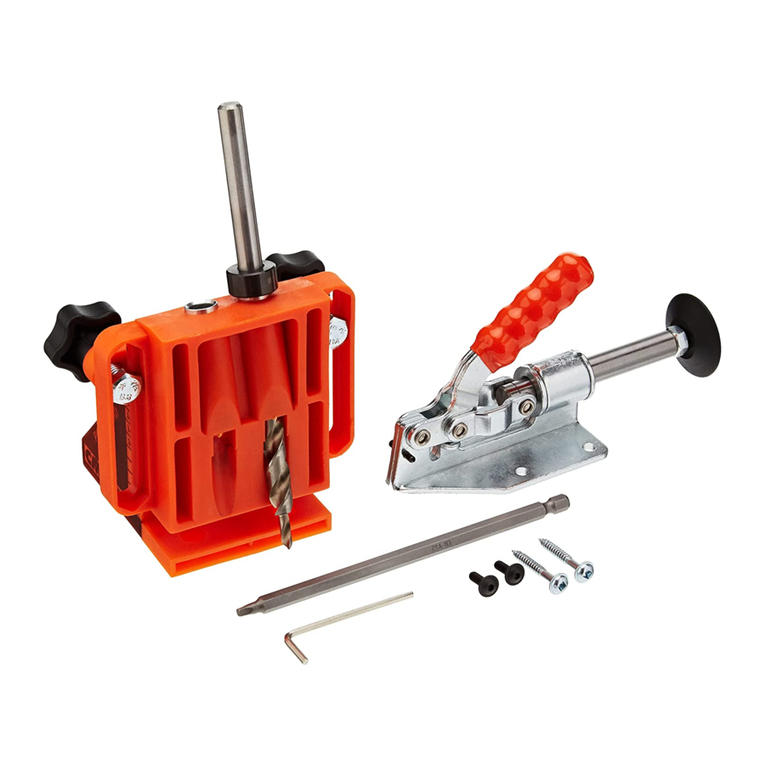
CMT ORANGE TOOLS
CMT ORANGE TOOLS Pocket-Pro PPJ-001 User manual

CMT ORANGE TOOLS
CMT ORANGE TOOLS 230.312.08M Use and care manual
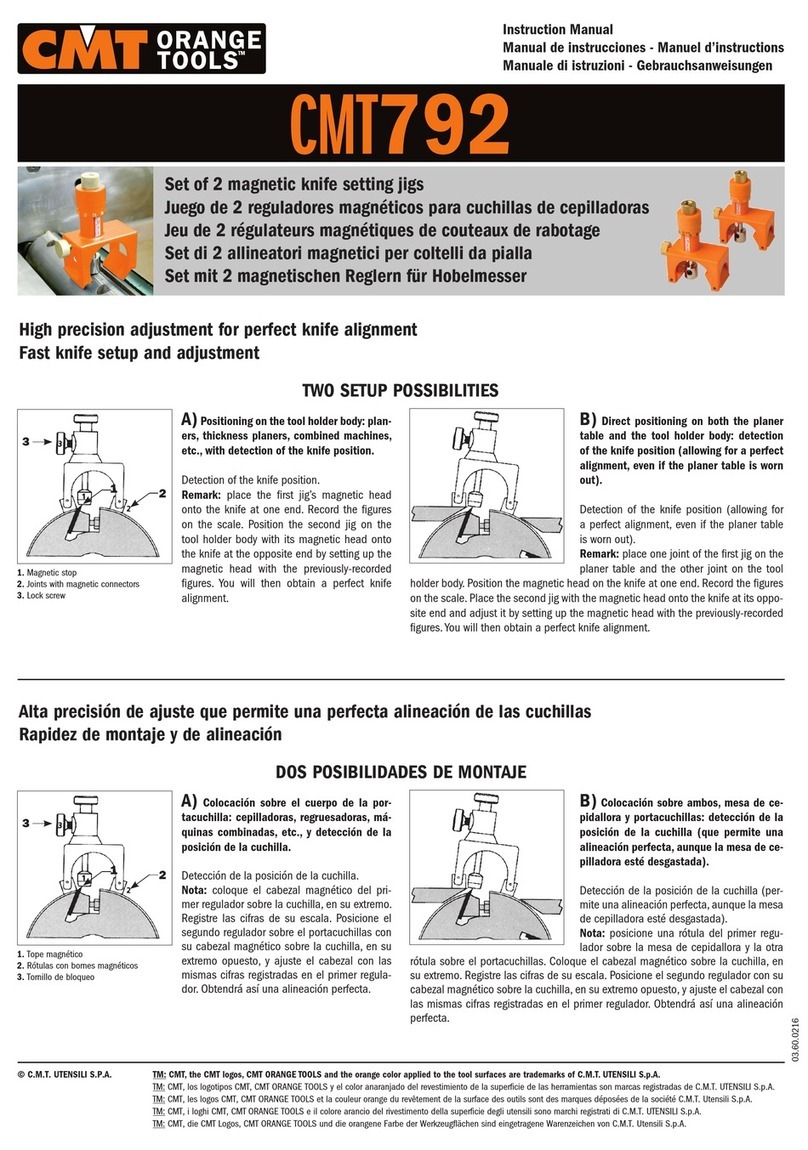
CMT ORANGE TOOLS
CMT ORANGE TOOLS CMT792 User manual
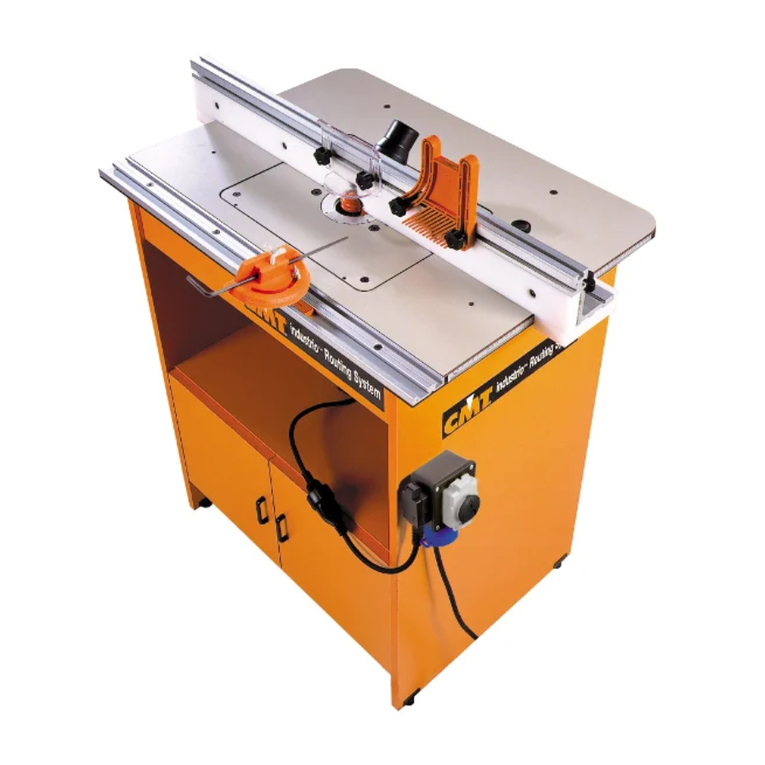
CMT ORANGE TOOLS
CMT ORANGE TOOLS Industrio Operating instructions

CMT ORANGE TOOLS
CMT ORANGE TOOLS CMT200 Assembly instructions
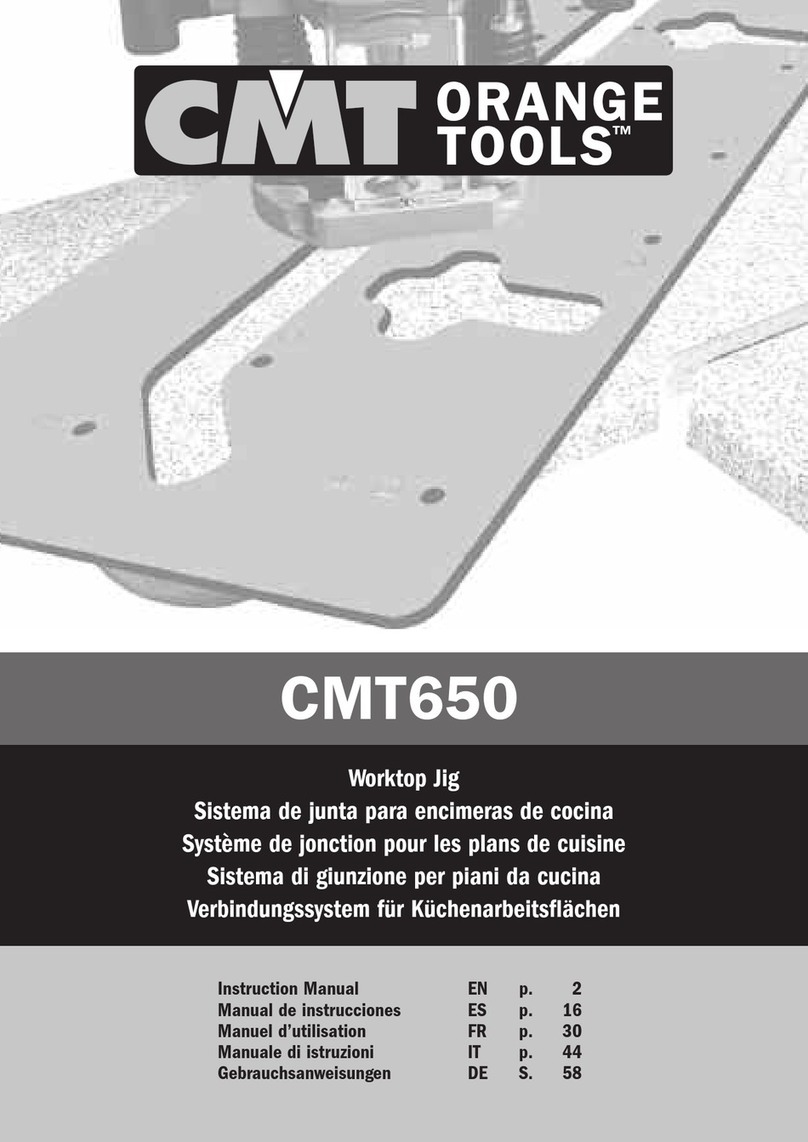
CMT ORANGE TOOLS
CMT ORANGE TOOLS CMT650 User manual





